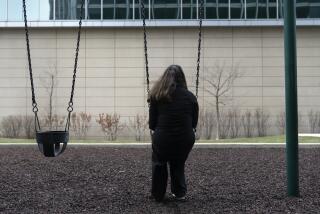Eating Habits Put Teens at Risk, Study Says
- Share via
Fattened by fast food and immobilized by TV and video games, a surprising segment of California teenagers is heading into adulthood at greater risk of chronic disease and even premature death, according to the first comprehensive statewide study of youths’ eating and exercise habits.
The 1998 telephone survey of more than 1,200 12- to 17-year-olds found that nearly a third of the youths were overweight or on the verge of being so. Half reported eating no vegetables the day before and a third had consumed at least one fast-food meal.
In general, the youths spent twice as much time watching TV or playing video games as exercising. And fewer than one in three got the recommended hour of daily physical activity.
“The proportion of kids with these risk factors [who are] so very young is very worrisome,” said Susan Foerster, chief of the cancer prevention and nutrition section of the California Department of Health Services, which oversaw the survey done by the Berkeley-based Public Health Institute. “I have to say we’ve been surprised.”
Some children and parents weren’t surprised.
“Parents are busy and the kids most of the time don’t know how to cook healthy food,” said Sarai Torres, a 17-year-old Fontana High School senior who watches four hours of television a day and frequents fast-food places three or four times a week.
But she knows the food can be bad for her and confided that she’d like to shed a few pounds. “I get afraid that what I eat now is going to affect me in the long run.”
Jason Deleo, 17, a senior at Hollywood High School, is a self-confessed fast-food junkie who is also worried. “I don’t want to get any of that bypass surgery stuff,” he said.
The results of the study, funded by the California Endowment, conform with national trends. Nationwide, particularly in the last decade, both children and adults are getting fatter. The percentage of children deemed overweight has doubled since the mid-1970s.
Fighting this trend “for us . . . is a major priority,” said Dr. William Dietz of the U.S. Centers for Disease Control and Prevention in Atlanta, noting that obesity leads to about 300,000 deaths a year.
Studies have shown that certain chronic diseases related to nutrition and weight--such as Type II diabetes--are striking people younger, even in childhood. Type II diabetes is particularly worrisome in some ethnic groups, such as African Americans, Latinos and Native Americans.
“It used to be called adult-onset diabetes,” said Dr. Carmen Nevarez, vice president of the Public Health Institute, a nonprofit research organization. “It’s really ominous” that it is occurring in youngsters, she said.
Being overweight in youth is a strong predictor for adult obesity and other chronic ailments, such as hypertension, high blood cholesterol, coronary heart disease, stroke and cancer.
The chances of an overweight adolescent being of normal weight as an adult are less than 50%, researchers said. In adolescent males, being even moderately overweight has been associated with increased mortality in adulthood. Overweight children as young as 5 have been found to have one or more risk factors for heart disease.
Though they tend to be more active than their parents, youngsters in many ways follow in their footsteps. Tufts University researchers found last year that 63% of men and 55% of women over the age of 25 are obese or overweight, the highest rate ever recorded. The numbers in California are just slightly better.
The problem stems from increased intake of foods high in fat
and calories in an increasingly sedentary, convenience-minded culture, experts said. Several studies have suggested that prolonged television watching in itself is a cause of obesity. One national survey found that the prevalence of adolescent obesity increased 2% for each additional hour of TV viewing.
Harold Goldstein, executive director of the California Center for Public Health Advocacy, blames advertisers who target youngsters.
“The general message is ‘Eat as much as you can for as little cost as you can,’ ” he said. “Rather than get a regular [order of] fries, you can get supersize. . . . instead of a can of Coke you can get a super Big Gulp.”
In addition, Goldstein said schools are failing youngsters by providing unhealthful snack foods in vending machines and failing to mandate and enforce stringent physical education requirements.
In California high schools, physical education is required only two out of four years. Goldstein described the results of the latest annual physical fitness tests in some grades as “an abomination.”
Statewide, nearly 42% of fifth-graders and seventh-graders and 51% of ninth-graders were found to have aerobic capacity in the “not healthy” zone, Goldstein said.
Public Health Institute researchers were particularly disturbed that bad habits tended to go together. Poor diet tended to correlate with smoking and physical inactivity.
The study found marked gender and ethnic differences. Nearly twice as many boys as girls got the recommended hour of exercise daily. For girls, physical activity declined with age; for boys, it increased.
Consistent with findings among adults, the California study found that weight problems are most pronounced in certain minority groups. Half of African American adolescents and more than a third of Latino adolescents were found to be overweight or at risk of being overweight, compared to one-quarter of whites and Asians.
Adolescents in the study were classified as overweight if their body mass index exceeded the 95th percentile for their peer group; they were considered at risk of becoming overweight if their index exceeded the 85th percentile. The index takes into account weight, height, age and gender.
At least some good news emerged from the Public Health Institute study, researchers said: Teenagers are flexible and receptive to change through education.
Experts said changes need to be made to ensure that good habits are reinforced rather than discouraged. “If we don’t do that, kids are going to pay with their lives,” Goldstein said.
*
Times staff writer Duke Helfand contributed to this story.
(BEGIN TEXT OF INFOBOX / INFOGRAPHIC)
Eating Habits
Percentages of California adolescents (ages 12-17) who met minimum daily diet and exercise ecommendations, 1998
Boys who ate seven or more servings of fruits and vegetables: 23%
Girls who ate five or more servings of fruits and vegetables: 38%
Adolescents (girls and boys) who ate four or more servings of fruits and grains: 19%
Adolescents who ate or drank three or more servings of milk products: 70%
Adolescents who ate one or more servings of beans: 45%
Adolescents who had one or more hours of physical actvity: 29%
Adolescents who met all dietary and activity recommendations: 2%
Adolescents who met no dietary and activity recommendations: 8%
*
Source: Public Health Institute
More to Read
Sign up for Essential California
The most important California stories and recommendations in your inbox every morning.
You may occasionally receive promotional content from the Los Angeles Times.













